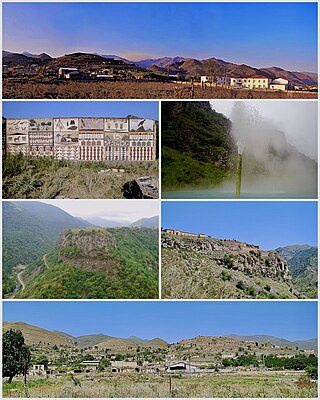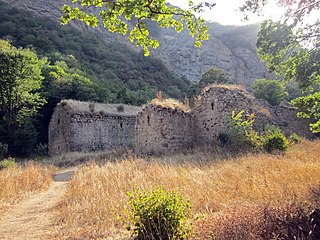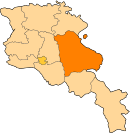
Gegharkunik is a province (marz) of Armenia. Its capital and largest city is Gavar. Gegharkunik is inhabited by approximately 209,669 people and the majority are ethnic Armenians.

Kalbajar District is one of the 66 districts of Azerbaijan. It is located in the west of the country and belongs to the East Zangezur Economic Region. The district borders the districts of Lachin, Khojaly, Agdam, Tartar, Goranboy, Goygol and Dashkasan districts of Azerbaijan, as well as the Gegharkunik and Vayots Dzor provinces of Armenia. Its capital and largest city is Kalbajar. As of 2020, the district had a nominal population of 94,100.

Shahumyan Province was a province of the breakaway Republic of Artsakh, de jure part of the Republic of Azerbaijan. The capital of the province was Karvachar. Shahumyan Province had 17 communities of which one is considered urban and 16 are rural. Its bordered Martakert Province to the east, Kashatagh Province to the south, Gegharkunik and Vayots Dzor provinces of Armenia to the west and Dashkasan, Goygol and Goranboy districts of Azerbaijan to the north.

Vardenis is a town in the Vardenis Municipality of the Gegharkunik Province of Armenia. It is located in the valley of the Masrik River, on the territory of the Masrik artesian basin at 2,006 metres above sea level, near the southeastern shores of Lake Sevan. It is 170 kilometres by road east of the capital Yerevan, and 75 kilometres southeast of the provincial centre Gavar. The administrative territory of Vardenis comprises 3,006 hectares, of which 736 hectares is occupied by the town itself. Vardenis obtained its status as an urban settlement in 1995. As of the 2011 census, the population of the town was 12,685. However, as per the 2016 official estimate, the population of Vardenis is 12,600.

Mehmana is a village located in the Kalbajar District of Azerbaijan, in the region of Nagorno-Karabakh. Until 2023 it was controlled by the breakaway Republic of Artsakh. The village had an ethnic Armenian-majority population until the exodus of the Armenian population of Nagorno-Karabakh following the 2023 Azerbaijani offensive in Nagorno-Karabakh.
Arpunk is a village in the Vardenis Municipality of the Gegharkunik Province of Armenia. Three kilometers southeast of the village is a 15th-century church. The village was populated by Azerbaijanis before the exodus of Azerbaijanis from Armenia after the outbreak of the Nagorno-Karabakh conflict. In 1988-1989 Armenian refugees from Azerbaijan settled in the village.
Avazan is a village in the Vardenis Municipality of the Gegharkunik Province of Armenia. The village was populated by Azerbaijanis before the exodus of Azerbaijanis from Armenia after the outbreak of the Nagorno-Karabakh conflict. In 1988-1989 Armenian refugees from Azerbaijan settled in the village.
Kutakan is a village in the Vardenis Municipality of the Gegharkunik Province of Armenia.

Norabak is a village in the Vardenis Municipality of the Gegharkunik Province of Armenia. The village was populated by Azerbaijanis before the exodus of Azerbaijanis from Armenia after the outbreak of the Nagorno-Karabakh conflict. In 1988-1989 Armenian refugees from Azerbaijan settled in the village.

Pokr Masrik is a village in the Vardenis Municipality of the Gegharkunik Province of Armenia. Azerbaijanis lived in the village prior to their exodus from Armenia after the outbreak of the Nagorno-Karabakh conflict. From 1988 and onward, Armenian refugees from Azerbaijan settled in the village. The village is located close to Mets Masrik.
Shatjrek is a village in the Vardenis Municipality of the Gegharkunik Province of Armenia. The village was populated by Azerbaijanis before the exodus of Azerbaijanis from Armenia after the outbreak of the Nagorno-Karabakh conflict. In 1988-1989 Armenian refugees from Azerbaijan settled in the village.

Kalbajar is a city and the capital of the Kalbajar District of Azerbaijan. Located on the Tartar river valley, it is 458 kilometres (285 mi) away from the capital Baku.
Arajadzor or Dovshanly is a village located in the Kalbajar District of Azerbaijan, in the region of Nagorno-Karabakh. Until 2023 it was controlled by the breakaway Republic of Artsakh. The village had an ethnic Armenian-majority population until the exodus of the Armenian population of Nagorno-Karabakh following the 2023 Azerbaijani offensive in Nagorno-Karabakh.

Dashalty or Karin Tak is a village in the Shusha District of Azerbaijan, in the region of Nagorno-Karabakh. Until 2020, the village was controlled by the Republic of Artsakh. The village had an ethnic Armenian-majority population prior to the 2020 Nagorno-Karabakh war, and also had an Armenian majority in 1989.

Zar is a village in the Kalbajar District of Azerbaijan.

The Armenian-occupied territories surrounding Nagorno-Karabakh were areas of Azerbaijan, situated around the former Nagorno-Karabakh Autonomous Oblast (NKAO), which were occupied by the ethnic Armenian military forces of the breakaway Republic of Artsakh with military support from Armenia, from the end of the First Nagorno-Karabakh War (1988–1994) to 2020, when the territories were returned to Azerbaijani control by military force or handed over in accordance to the 2020 Nagorno-Karabakh ceasefire agreement. The surrounding regions were seized by Armenians under the justification of a "security belt" which was to be traded for recognition of autonomous status from Azerbaijan.

Shosh or Shushikend is a village in the Khojaly District of Azerbaijan, in the region of Nagorno-Karabakh. Until 2023 it was controlled by the breakaway Republic of Artsakh. The village had an ethnic Armenian-majority population until the exodus of the Armenian population of Nagorno-Karabakh following the 2023 Azerbaijani offensive in Nagorno-Karabakh.

The Sotk gold mine, known in Azerbaijan as the Zod gold mine, is the largest mine in Armenia and Azerbaijan in terms of pure gold reserves. It is located in the vicinity of the Sotk village in the Vardenis region of Armenia's Gegharkunik Province, and the adjacent part of the Kalbajar District of Azerbaijan. According to Armenian officials, the gold mine is split roughly in half between the two countries, while according to Azerbaijani officials, 74 percent of the mine lies on Azerbaijani territory.

Operation Kalbajar was a military offensive launched by the Azerbaijani Armed Forces in late 1993 against the forces of the Armenian Army and the self-proclaimed Nagorno-Karabakh Republic to recapture the district of Kalbajar in the final stage of the First Nagorno-Karabakh War.

Kusanats Anapat, or Surb Astvatsatsin is an Armenian monastery in the Kalbajar District in Azerbaijan, about 3 km northwest of Dadivank Monastery.



























